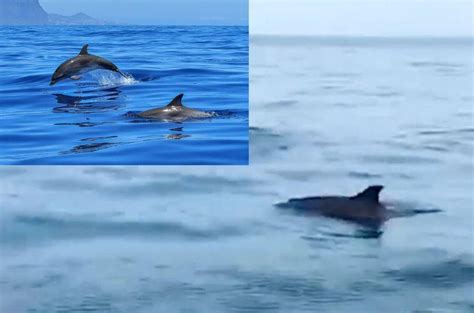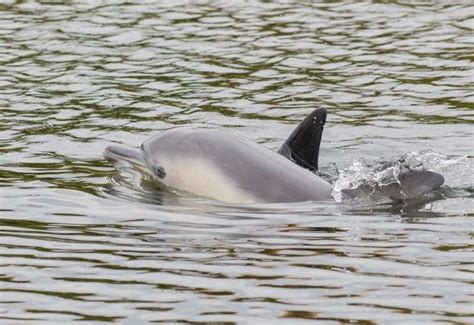
Dolphins have been sighted in inland waterways, prompting authorities to issue warnings for the public to keep a safe distance and avoid interaction. The unusual occurrence raises concerns for the dolphins’ well-being and highlights the importance of responsible wildlife observation.
Authorities are urging the public to maintain a safe distance from dolphins spotted in inland waterways, emphasizing the potential harm that human interaction can cause to these marine mammals. The recent sightings have sparked both excitement and concern, with experts cautioning against approaching or feeding the animals.
The Okaloosa County Sheriff’s Office issued an advisory following reports of dolphins venturing into Choctawhatchee Bay, an uncommon habitat for the species. “Deputies responded to a call in reference to dolphins in the bay behind homes in the Bayshore Drive area,” the Sheriff’s Office stated. The Florida Fish and Wildlife Conservation Commission (FWC) has also been notified and is monitoring the situation.
The primary concern is the safety and well-being of the dolphins themselves. Marine mammals are susceptible to stress and injury when approached or handled by humans. Feeding dolphins, in particular, can alter their natural behaviors and make them dependent on humans for food, ultimately jeopardizing their survival skills. The FWC strongly advises against feeding wild dolphins, as it is both harmful and illegal.
Experts believe that the dolphins may have entered the bay in search of food or due to navigational errors. Changes in water conditions, such as salinity levels or prey availability, can also influence dolphin movements. Regardless of the reason, it is crucial to allow the dolphins to navigate their way back to their natural habitat without interference.
Interacting with dolphins can also pose risks to humans. While dolphins are generally considered friendly, they are still wild animals and can become unpredictable if they feel threatened or stressed. Their powerful jaws and teeth can inflict serious injuries. Therefore, maintaining a safe distance is essential for both human and animal safety.
The FWC recommends observing dolphins from a distance of at least 50 yards. This allows the animals to behave naturally and reduces the risk of disturbance. Boaters are also advised to operate their vessels at slow speeds and avoid creating wakes near dolphins.
The appearance of dolphins in inland waterways serves as a reminder of the importance of responsible wildlife stewardship. By respecting their space and avoiding interaction, we can help ensure the well-being of these magnificent creatures and preserve their natural behaviors.
Dolphin Behavior and Ecology
Dolphins are highly intelligent marine mammals belonging to the family Delphinidae. They are found in oceans all over the world and some species also inhabit rivers and estuaries. These social animals typically live in groups called pods, which can range in size from a few individuals to several hundred.
Dolphins are known for their playful behavior and complex communication skills. They use a variety of vocalizations, including clicks, whistles, and pulsed calls, to communicate with each other. They also use body language, such as breaching and tail-slapping, to convey messages.
Dolphins are carnivores and their diet consists mainly of fish, squid, and crustaceans. They use echolocation to locate prey, emitting high-frequency sounds and listening for the echoes that bounce back from objects in the water. This allows them to hunt effectively even in murky or dark conditions.
Dolphins play an important role in marine ecosystems. As apex predators, they help to regulate populations of their prey species and maintain the balance of the food web. They are also indicators of environmental health, as they are sensitive to pollution and other stressors.
Threats to Dolphin Populations
Dolphin populations face a number of threats, including habitat loss, pollution, entanglement in fishing gear, and climate change.
Habitat loss is a major concern, as coastal development and other human activities destroy or degrade important dolphin habitats, such as feeding grounds and breeding areas.
Pollution can also harm dolphins, as they are exposed to toxins and contaminants that accumulate in their tissues. These pollutants can weaken their immune systems, impair their reproductive abilities, and even cause death.
Entanglement in fishing gear is another significant threat to dolphins. They can become entangled in nets, lines, and traps, which can lead to drowning or serious injury.
Climate change is also expected to have a negative impact on dolphin populations, as rising sea temperatures and changes in ocean currents can alter their prey distribution and disrupt their migration patterns.
Conservation Efforts
Numerous organizations and agencies are working to protect dolphins and their habitats. These efforts include:
- Establishing marine protected areas to safeguard important dolphin habitats.
- Implementing regulations to reduce pollution and prevent entanglement in fishing gear.
- Conducting research to better understand dolphin behavior and ecology.
- Educating the public about the importance of dolphin conservation.
By working together, we can help ensure the survival of these magnificent creatures for generations to come.
The Specific Case in Choctawhatchee Bay
The appearance of dolphins in Choctawhatchee Bay is not entirely unprecedented, but it is still considered unusual. The bay is a shallow, brackish water body that is typically home to a different suite of marine species than the open ocean. While dolphins may occasionally venture into the bay in search of food, they do not usually stay for extended periods.
The current sightings have raised concerns because the dolphins appear to be lingering in the bay, suggesting that they may be having difficulty finding their way back to the Gulf of Mexico. There is also a risk that they could become disoriented or injured in the shallow waters of the bay.
The FWC is monitoring the situation closely and is prepared to intervene if the dolphins appear to be in distress. However, their primary goal is to allow the dolphins to return to their natural habitat on their own. This is because capturing and relocating dolphins can be stressful and may not always be successful.
In the meantime, the public is urged to cooperate with authorities and follow their recommendations to avoid interacting with the dolphins. This includes maintaining a safe distance, refraining from feeding them, and reporting any sightings to the FWC.
Ethical Considerations of Wildlife Encounters
The incident with the dolphins highlights broader ethical considerations concerning human interactions with wildlife. While the allure of observing or interacting with wild animals is understandable, it is crucial to prioritize their well-being and avoid actions that could cause them harm.
Responsible wildlife tourism emphasizes the importance of minimizing disturbance to animals and their habitats. This includes following guidelines such as maintaining a safe distance, avoiding loud noises, and refraining from feeding animals.
Feeding wild animals, in particular, can have numerous negative consequences. It can alter their natural foraging behaviors, make them dependent on humans for food, and increase their risk of disease. It can also lead to conflicts between humans and animals, as animals may become aggressive in their search for food.
Ultimately, our interactions with wildlife should be guided by respect and a commitment to their conservation. By prioritizing their well-being, we can help ensure that these magnificent creatures continue to thrive in their natural environments.
The Role of Education and Awareness
Education and awareness play a critical role in promoting responsible wildlife stewardship. By educating the public about the importance of protecting dolphins and other marine animals, we can foster a greater sense of responsibility and encourage behaviors that support their conservation.
Educational programs can cover a wide range of topics, including dolphin behavior and ecology, threats to dolphin populations, and ways to reduce our impact on the marine environment. These programs can be targeted at different audiences, such as school children, boaters, and tourists.
Awareness campaigns can also be effective in raising public awareness about specific issues, such as the dangers of feeding wild dolphins or the importance of reducing plastic pollution. These campaigns can use a variety of media, such as social media, television, and print, to reach a wide audience.
By investing in education and awareness, we can empower individuals to make informed decisions that benefit both wildlife and the environment.
The Legal Framework for Dolphin Protection
In the United States, dolphins are protected under the Marine Mammal Protection Act (MMPA), which prohibits the harassment, hunting, capture, or killing of marine mammals. The MMPA also regulates activities that could potentially harm marine mammals, such as fishing and offshore development.
The MMPA is administered by the National Marine Fisheries Service (NMFS), which is responsible for managing and conserving marine mammal populations. NMFS also issues permits for scientific research and other activities that may involve marine mammals.
In addition to the MMPA, some states also have their own laws and regulations to protect dolphins. In Florida, for example, it is illegal to feed wild dolphins or to disturb their natural behavior.
These legal protections are essential for ensuring the long-term survival of dolphin populations. By enforcing these laws and regulations, we can help to reduce the threats that dolphins face and protect their habitats.
Long-Term Implications
The increasing frequency of unusual wildlife sightings, like the dolphins in Choctawhatchee Bay, could be indicative of larger environmental shifts. Climate change, pollution, and habitat degradation are all contributing to changes in animal behavior and distribution.
Monitoring these events and understanding the underlying causes is crucial for developing effective conservation strategies. This requires ongoing research, collaboration between scientists and policymakers, and a commitment to protecting our natural resources.
The story of the dolphins serves as a reminder of the interconnectedness of ecosystems and the importance of responsible stewardship. By taking action to protect dolphins and their habitats, we can also benefit other species and ensure the health of our planet.
FAQ: Dolphins Spotted Inland
-
Why are dolphins being spotted in inland waterways like Choctawhatchee Bay?
- Dolphins may venture into inland waterways for several reasons, including searching for food, navigational errors, or changes in water conditions such as salinity or prey availability. According to authorities, these appearances can be attributed to a search for sustenance or disorientation.
-
What should I do if I see a dolphin in an unusual location?
- If you encounter a dolphin in an inland waterway, it is crucial to maintain a safe distance of at least 50 yards. Avoid approaching, feeding, or attempting to interact with the animal. Report the sighting to the Florida Fish and Wildlife Conservation Commission (FWC) or local authorities.
-
Is it dangerous to be near a dolphin?
- While dolphins are generally considered friendly, they are still wild animals and can become unpredictable if they feel threatened or stressed. They possess powerful jaws and teeth that can inflict serious injuries. Maintaining a safe distance is essential for both human and animal safety.
-
Is it illegal to feed dolphins in the wild?
- Yes, feeding wild dolphins is illegal under both federal and state laws. Feeding dolphins can alter their natural foraging behaviors, make them dependent on humans for food, and increase their risk of disease. It can also lead to conflicts between humans and animals. The FWC strictly advises against it.
-
What is the FWC doing to help the dolphins in Choctawhatchee Bay?
- The FWC is monitoring the situation closely and is prepared to intervene if the dolphins appear to be in distress. Their primary goal is to allow the dolphins to return to their natural habitat on their own. Capturing and relocating dolphins can be stressful and may not always be successful, so it’s a last resort.
-
What is the Marine Mammal Protection Act (MMPA)?
The Marine Mammal Protection Act (MMPA) is a United States federal law enacted in 1972. Its primary goal is to protect marine mammals, including dolphins, whales, seals, sea lions, and others, from various threats. The MMPA prohibits the “take” of marine mammals, which includes harassment, hunting, capture, or killing. The act also establishes guidelines for managing and conserving marine mammal populations and regulates activities that could potentially harm them, such as fishing and offshore development.
-
What are some of the long-term threats to dolphin populations?
Long-term threats to dolphin populations include habitat loss, pollution (chemical and noise), entanglement in fishing gear, climate change (affecting prey distribution and migration patterns), and direct harm from human activities. These factors can impact dolphin health, reproduction, and survival rates.
-
How does climate change affect dolphins?
Climate change affects dolphins through rising sea temperatures, altered ocean currents, and changes in prey distribution. Warmer waters can lead to shifts in the availability of fish and other food sources, forcing dolphins to travel farther to find sustenance. Changes in ocean currents can also disrupt migration patterns and breeding cycles, impacting dolphin populations.
-
What are the signs that a dolphin is in distress?
Signs that a dolphin may be in distress include unusual behavior (e.g., stranding, circling repeatedly), visible injuries (e.g., cuts, entanglement), lethargy or weakness, and failure to swim or dive properly. If you observe these signs, report them immediately to the FWC or local authorities.
-
What role do dolphins play in the marine ecosystem?
Dolphins are apex predators in the marine ecosystem, meaning they are at the top of the food chain. They help regulate populations of their prey species, maintaining balance in the food web. They are also considered indicators of environmental health, as they are sensitive to pollution and other stressors, reflecting the overall health of the marine environment.
-
How do dolphins communicate with each other?
Dolphins communicate using a variety of methods, including vocalizations such as clicks, whistles, and pulsed calls. They also use body language, such as breaching, tail-slapping, and pectoral fin rubbing, to convey messages. Echolocation, the emission of high-frequency sounds and listening for the echoes, is primarily used for hunting but also aids in communication.
-
What is the typical social structure of dolphins?
Dolphins typically live in social groups called pods, which can vary in size from a few individuals to several hundred. Pods are dynamic and can change in composition over time. Social bonds are important for cooperation in hunting, protection from predators, and raising young. Different dolphin species may exhibit variations in their social structures.
-
What is echolocation and how do dolphins use it?
Echolocation is a biological sonar system used by dolphins to locate prey and navigate their environment. Dolphins emit high-frequency clicks and listen for the echoes that bounce back from objects in the water. By analyzing the timing, direction, and intensity of the echoes, dolphins can determine the size, shape, distance, and location of objects, even in murky or dark conditions.
-
What types of pollution are most harmful to dolphins?
Several types of pollution can harm dolphins, including chemical pollution (e.g., pesticides, heavy metals, PCBs), noise pollution (e.g., from shipping, sonar), and plastic pollution. Chemical pollutants can accumulate in dolphin tissues, weakening their immune systems and impairing their reproductive abilities. Noise pollution can disrupt communication and foraging behavior. Plastic pollution can lead to entanglement or ingestion, causing injury or death.
-
How can boaters help protect dolphins?
Boaters can help protect dolphins by operating their vessels at slow speeds in areas where dolphins are known to frequent, avoiding sudden changes in direction, and maintaining a safe distance. They should also be mindful of noise pollution and avoid using loud sonar or other devices that could disturb dolphins. It is crucial to properly dispose of trash and fishing gear to prevent entanglement.
-
What is a marine protected area (MPA) and how does it help dolphins?
A marine protected area (MPA) is a designated area in the ocean or coastal waters that is managed to protect marine ecosystems and biodiversity. MPAs can help dolphins by safeguarding important habitats such as feeding grounds and breeding areas. They often restrict activities that could harm dolphins, such as fishing, shipping, and coastal development.
-
What are the key differences between different dolphin species?
Different dolphin species vary in size, appearance, behavior, and habitat preferences. For example, bottlenose dolphins are found in coastal and offshore waters worldwide, while spinner dolphins are known for their acrobatic displays. Some species live in freshwater rivers, while others are adapted to deep ocean environments.
-
What are some successful examples of dolphin conservation efforts?
Successful dolphin conservation efforts include the establishment of marine protected areas, regulations to reduce bycatch in fisheries, and public awareness campaigns to promote responsible dolphin watching. Efforts to reduce pollution and habitat degradation have also contributed to the recovery of some dolphin populations.
-
How can I support dolphin conservation efforts?
You can support dolphin conservation efforts by donating to organizations dedicated to marine mammal research and protection, participating in citizen science projects (e.g., reporting dolphin sightings), reducing your consumption of single-use plastics, and advocating for policies that protect dolphins and their habitats. Also, making informed seafood choices can reduce bycatch.
-
What are the potential consequences of human intervention when dolphins venture into unusual habitats?
Human intervention, such as trying to feed or relocate dolphins in unusual habitats, can have negative consequences. Feeding dolphins can alter their natural foraging behaviors and make them dependent on humans. Attempts to relocate them can cause stress and injury. It is generally best to allow dolphins to find their way back to their natural habitat with minimal interference, while reporting sightings to the appropriate authorities for monitoring.









